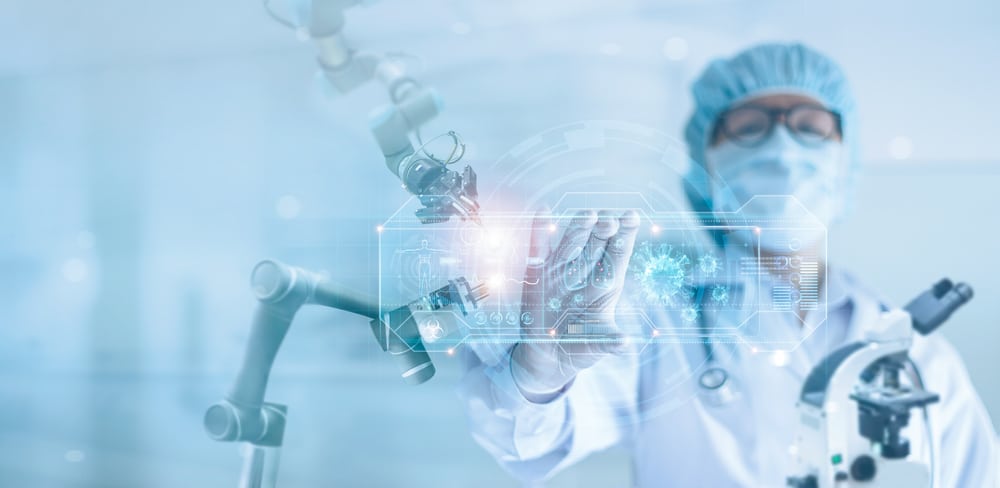How COVID-19 sparked a revolution in healthcare machine learning and AI

In the past six months, COVID-19 has evolved from a speck on the world radar to a full-blown pandemic. While it has claimed the lives of many and shed a massive spotlight on some of the major issues in healthcare, it has also served as a catalyst for innovation.
As with nearly every element of the healthcare system, applications of machine learning and artificial intelligence (AI) have also been transformed by the pandemic. Although the power of machine learning and AI was being put to significant use prior to the Coronavirus outbreak, there is now increased pressure to understand the underlying patterns to help us prepare for any epidemic that might hit the world in the future.
How have AI interventions fared so far?
As 2019 neared its end, an AI platform based in Canada picked up an anomaly half a world away. The platform, BlueDot, registered a cluster of unusual pneumonia cases in Wuhan, China, based on its natural language processing to track, identify and report on the spread of the virus. BlueDot had spotted what would later be known as COVID-19.
While BlueDot was one of the early AI interventions in the battle against COVID-19, the healthcare world has scaled up its use of intelligent algorithms to predict the number of affected lives, screen patients, enable quicker diagnosis and research a possible vaccine. In addition to BlueDot, innovative AI applications have surfaced in many parts of the world. China-based Alibaba revealed an AI algorithm that could diagnose suspect cases with 96 percent accuracy in just 20 seconds. The University of Chicago Medical Center is also working on enhancing eCART, which was launched in 2015 and can predict which patients are at risk of a cardiac arrest and would need to be admitted into intensive care units within eight hours. A partnership between Google Cloud and Harvard Medical School and Dana Farber Cancer Institute is focused on building an open-source virtual drug discovery platform to analyze potential treatments rapidly.
However, the role of such algorithms doesn’t stop at identification. As the U.S. healthcare system continues to monitor the spread of the virus and develops plans to relax social distancing and stay-at-home orders, the response efforts need to go beyond controlling the pandemic. For many organizations battered and overwhelmed, this would mean implementing machine learning and AI in their operations to mitigate the outbreak.
The power of prediction and personalization
We’re all well aware of the use of AI and machine learning by tech companies for travel, insurance, retail, or even media services to personalize recommendations for us on best discount offers or our preferences. These algorithms customize prices, risk and the like for users by analyzing data from consumers including preferences and search patterns.
Extending this application to healthcare, machine learning and AI can play a significant role in understanding an individual’s clinical risk: is this person at a high risk of contracting a particular infection? What is the probability they would have complications or need to be admitted to an ICU? How likely is that they would need to be re-admitted after discharge, or would not survive? Analysis on clinical data such as patient history, comorbidities, or socio-economic data could reveal significant insights into a patient’s health. For example, a patient with diabetes would be classified with a high-risk profile for complications if they contracted COVID-19.
These clinical risk predictions can be extended and used to customize resource allocation at hospitals, appropriately accounting for clinical risk. These predictions can also be helpful in triaging patients as stay-at-home orders are being gradually lifted. Given that diagnosing people is challenging and testing at a large scale is difficult, the process can be slow in comparison to the exponential growth of the virus. Additionally, overwhelmed hospitals and clinics cannot risk crowded waiting rooms or deprioritizing high-risk patients.
Instead of taking samples from each patient and waiting for lab reports to reveal findings, hospitals can leverage app-based tests to identify critical details about their patients as they call to make an appointment. Data such as their previous illness episodes and travel and contact history can be useful in triaging patients. Patients that are at higher risk could be called into the hospital for immediate treatment, while low-risk patients can benefit from virtual visits or telehealth consultations.
What’s holding us back
While AI and machine learning are proving to be instrumental in battling COVID-19, the lack of clean, standardized data is a considerable challenge.
In order to let the algorithms learn, they first have to be fed a massive amount of data. When COVID-19 emerged, data was initially non-existent, which made predictions difficult. In fact, to enable predictions or to see any patterns in infection spread would require capturing enough data from different geographic locations.
But before this data can be analyzed, it needs to be integrated and standardized. These algorithms would require clinical data from electronic health records, lab systems and claims along with publicly available databases, which should be available seamlessly across systems with as little delay as possible. A dataset with thousands of elements such as vital signs, lab results and demographic information is good enough to enable some level of prediction and the quality will only improve as more data is added.
Needless to say, the implementation of these algorithms will require policy changes. Privacy is a major concern when it comes to storing and sharing healthcare data and while existing policies cover data privacy and cybersecurity, sharing it across different data systems or geographical regions would require appropriate and secure channels.
The road ahead
Healthcare systems around the world, especially the most advanced ones, are some of the most complicated systems existing today. Even before the COVID-19 outbreak, the power of AI was being leveraged in multiple settings, but these instances of AI have provided a glimpse into the sea of possibilities that lie ahead. If we take this opportunity to build on the foundation we have created, we can save many lives -- both now and in the future.
Photo credit: PopTika / Shutterstock
 Abhinav Shashank is the CEO and co-founder of Innovaccer, a leading San Francisco based healthcare technology company. He built the foundation for Innovaccer’s success as a leader in population health management and machine learning-oriented healthcare solutions recognized by Gartner, KLAS, Forbes, Black Book Market Research, and others. Abhinav’s continued efforts and ambition enabled the company to flourish in health information technology in the U.S. and acquire over 25 healthcare organizations as customers, with more than 25,000 providers using Innovaccer’s solutions daily.
Abhinav Shashank is the CEO and co-founder of Innovaccer, a leading San Francisco based healthcare technology company. He built the foundation for Innovaccer’s success as a leader in population health management and machine learning-oriented healthcare solutions recognized by Gartner, KLAS, Forbes, Black Book Market Research, and others. Abhinav’s continued efforts and ambition enabled the company to flourish in health information technology in the U.S. and acquire over 25 healthcare organizations as customers, with more than 25,000 providers using Innovaccer’s solutions daily.